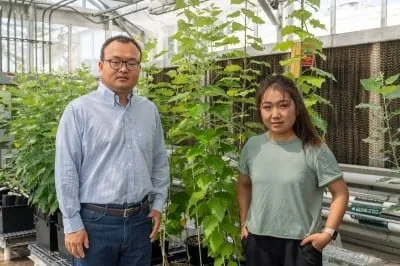
Breakthrough in Bioenergy: Biologists Create Supercharged Crops for Fuel and Bioproducts!
2025-09-04
Author: Li
In a stunning breakthrough, biologists at Brookhaven National Laboratory are unlocking the secrets of plant cell walls—revealing their potential to be a goldmine for energy and sustainable materials. Imagine crops not just surviving, but thriving on barren land, yielding abundant biofuels and chemical products!
Their latest research, published in The Plant Biotechnology Journal, has spotlighted a crucial plant protein, PtrbHLH011, which plays a pivotal role in poplar plant growth, disease resistance, and the development of robust cell walls. This discovery could revolutionize crop engineering, enabling farmers to cultivate bioenergy superstars.
Meng Xie, the lead biologist on the study, explained how this protein’s genetic mechanisms are intricately tied to how plants cope with nutritional stress, especially in iron-deficient conditions. "Understanding these genes could lead to crops that not only survive on less than optimal soils but also absorb critical minerals more efficiently," Xie stated.
Traditionally, researchers have focused on boosting sugars from cell walls for biofuel production. However, lignin—a key structural element—has emerged as a valuable resource for industrial byproducts such as cement and adhesives. The challenge? Balancing lignin levels without stunting plant growth.
In a groundbreaking experiment, scientists knocked out the PtrbHLH011 gene in poplars and observed astonishing results: the modified plants produced double the lignin while also experiencing unprecedented growth. Even more surprisingly, these plants accumulated three times more iron in their leaves—crucial for promoting photosynthesis!
But there's more! This increase in iron also led to enhanced flavonoid production—compounds vital for disease resistance. As biologists ramp up efforts to prepare for emerging agricultural threats, this discovery could be the key to creating resilient crops that fend off pathogens without compromising biomass.
Yuqiu Dai, a postdoc involved in the study, highlighted the significance of PtrbHLH011, which functions as a transcription factor that regulates numerous genes. By selectively tweaking these genes, researchers believe they can more finely tune specific plant processes for maximum yield and health.
The collaborative nature of this research is worth noting; various facilities including the Joint Genome Institute and the Molecular Foundry have played instrumental roles in developing this comprehensive understanding. Together, they are transforming our approach to bioenergy and bioproducts, aligning with wider goals of sustainability and energy independence.
With continued research, the potential of these genetically enhanced crops may lead to a future where bioenergy isn't just a possibility—it's a thriving reality. Keep an eye out for these future super plants that promise to change the landscape of energy and materials in the U.S.


 Brasil (PT)
Brasil (PT)
 Canada (EN)
Canada (EN)
 Chile (ES)
Chile (ES)
 Česko (CS)
Česko (CS)
 대한민국 (KO)
대한민국 (KO)
 España (ES)
España (ES)
 France (FR)
France (FR)
 Hong Kong (EN)
Hong Kong (EN)
 Italia (IT)
Italia (IT)
 日本 (JA)
日本 (JA)
 Magyarország (HU)
Magyarország (HU)
 Norge (NO)
Norge (NO)
 Polska (PL)
Polska (PL)
 Schweiz (DE)
Schweiz (DE)
 Singapore (EN)
Singapore (EN)
 Sverige (SV)
Sverige (SV)
 Suomi (FI)
Suomi (FI)
 Türkiye (TR)
Türkiye (TR)
 الإمارات العربية المتحدة (AR)
الإمارات العربية المتحدة (AR)